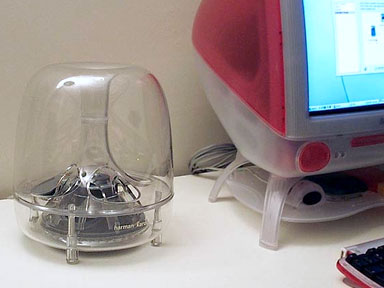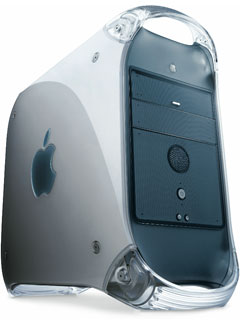Apple’s slot-loading iMac has arguably the best audio system available since the 20th Anniversary Macintosh. Engineered for three years by Harman/Kardon and utilizing rare-earth magnets, the Odyssey speakers provide unparalleled clarity and frequency response.

 2000: Earlier this year, Harman/Kardon also made available the long-awaited iSub subwoofer. Designed solely to complement the Odyssey system, it further increases frequency response and takes over all low-end sound output so the Odysseys can do their best at dishing out the treble and midrange. The divvying also allows the Odysseys to be twice as loud, making your iMac an even more viable replacement for your aging Sony boom box.
2000: Earlier this year, Harman/Kardon also made available the long-awaited iSub subwoofer. Designed solely to complement the Odyssey system, it further increases frequency response and takes over all low-end sound output so the Odysseys can do their best at dishing out the treble and midrange. The divvying also allows the Odysseys to be twice as loud, making your iMac an even more viable replacement for your aging Sony boom box.
This is all fantastic, and I applauded Apple for utilizing such a great set-up for making a vociferous computer out of an otherwise hushed one in Listen to the iMac. I can attest to the iMac’s audio prowess, too. I’m typing this article on my iMac DV right now.
However, Apple’s power users, the G4 owners, who are often more evangelical about their systems, get a considerably more meager helping of the sonic casserole.
Instead of speakers with a “High Fidelity Design Utilizing Rare Earth Neodymium Iron Boron Magnets And Featuring Spatializer Audio Laboratories Three Dimensional Simulated Surround Sound,” the Power Mac G4 has a single monaural speaker. Okay, Apple does have a good marketing reason for bringing better sound to the iMac first: It’s Apple’s best-selling and most heavily advertised computer, targeted more to consumer-electronics buyers.
 However, with a Sawtooth replacement imminent, it would be wise for our buddies in Cupertino to Odyssey-ize the G4 as well, and therein lies a problem. The G4 is Apple’s only modular Mac. It has a computer case and a separate monitor. With the current design, the one speaker is centrally located on the front of the system. The problem is, that design allows little space for stereo separation, even if two speakers were to be mounted there.
However, with a Sawtooth replacement imminent, it would be wise for our buddies in Cupertino to Odyssey-ize the G4 as well, and therein lies a problem. The G4 is Apple’s only modular Mac. It has a computer case and a separate monitor. With the current design, the one speaker is centrally located on the front of the system. The problem is, that design allows little space for stereo separation, even if two speakers were to be mounted there.
And, above that, the case is not the best place for sound to come from. Mini-towers like the G4 are designed to be mounted off-center from the monitor or under your desk. This layout kills any benefits of the stereo design of the Odyssey system, and leaves the sound susceptible to being obstructed by your desk and whatever else is down there.
Why not put the speakers inside the monitor? They’d be placed just like the iMac has them and share the same speaker housings and grilles as the iMac. Not only would this reduce the desk clutter that third-party speakers provide, but it would also allow G4 users to use the fantastic iSub subwoofer.
The flat-panel studio displays, which don’t have enough room to fit the Odyssey speakers, could use the ones Harman/Kardon is reportedly developing for the PowerBook and iBook lines. The iSub could likely be made to work with these speakers, but there have been no such announcements about these speakers yet.
To enhance the 3D surround sound, four speakers could be used! This multi-speaker setup would be a great way to market the forthcoming multiprocessor G4s. (Think, in the Jeff Goldblum voice, “Presenting the new multiprocessor, multi-speaker, Power Mac G4.”)
Also, the third-party speaker manufacturers wouldn’t be badly hurt, since many G4 users also use third-party monitors, and many 2000 iMac users use third-party speakers, since their non-built-in design improves stereo separation and allows for bigger transducers.
But the G4 should still keep some kind of dinky speaker built into the case that would turn off when using externals or the Odysseys, because removing that would make it the first-ever Macintosh to be able to operate PC-style, without any built-in audio! Scary, isn’t it?
keywords: #isub #soundsystem

